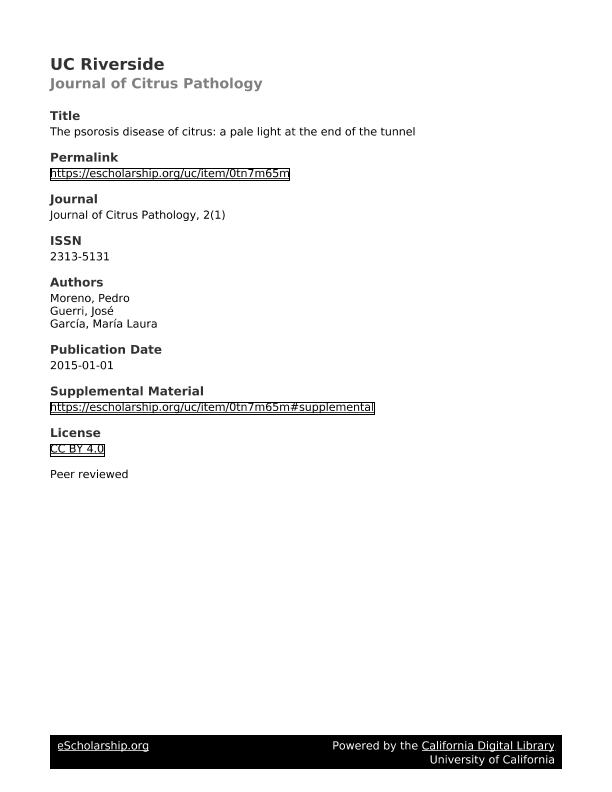Mostrar el registro sencillo del ítem
dc.contributor.author
Moreno, Pedro
dc.contributor.author
Guerri, Jose
dc.contributor.author
Garcia, Maria Laura

dc.date.available
2018-07-03T14:16:42Z
dc.date.issued
2015-12
dc.identifier.citation
Moreno, Pedro; Guerri, Jose; Garcia, Maria Laura; The psorosis disease of citrus: a pale light at the end of the tunnel; IOCV; Journal of Citrus Pathology; 2; 1; 12-2015; 1-18
dc.identifier.issn
2313-5131
dc.identifier.uri
http://hdl.handle.net/11336/50993
dc.description.abstract
First reported in 1896, psorosis was the first citrus disease proven to be graft transmissible and also the first for which eradication and budwood certification programs were launched to prevent its economic damage. For many years psorosis etiology remained elusive, and only in 1986 was the disease associated with the presence of virus-like particles in infected plants. However, in the last 2 decades a virus with unusual morphology (Citrus psorosis virus, CPsV) was characterized and closely associated with psorosis disease as previously defined by field symptoms and by biological indexing in sensitive indicator plants. With a tripartite, negative-sense, RNA genome and a ~48 kDa coat protein, CPsV, the presumed causal agent of psorosis, is the type member of the genus Ophiovirus, within the new family Ophioviridae. Availability of the complete genomic sequence of 2 CPsV isolates and partial sequences of many others has enabled i) setting up rapid and sensitive RNA-based detection methods, ii) testing different citrus and relatives for resistance to CPsV, iii) identification of the 2 components (psorosis A and psorosis B) traditionally associated with non-scaled and scaled bark inoculum, respectively, from psorosis-infected plants and study their interactions, iv) analysis of genetic variation and evolutionary forces shaping the CPsV populations, v) preliminary studies on the interactions between virus and host factors, and vi) development of transgenic citrus plants expressing variable degrees of resistance to CPsV. In summary, 120 years after the first report on psorosis we start seeing a pale light at the end of the tunnel.
dc.format
application/pdf
dc.language.iso
eng
dc.publisher
IOCV
dc.rights
info:eu-repo/semantics/openAccess
dc.rights.uri
https://creativecommons.org/licenses/by/2.5/ar/
dc.subject
Psorosis A
dc.subject
Psorosis B
dc.subject
Citrus Psorosis Virus (Cpsv)
dc.subject
Ophiovirus
dc.subject
Symptoms
dc.subject
Detection
dc.subject
Characterization
dc.subject
Genetic Variation
dc.subject
Citrus Resistance to Cpsv
dc.subject.classification
Otras Biotecnología Agropecuaria

dc.subject.classification
Biotecnología Agropecuaria

dc.subject.classification
CIENCIAS AGRÍCOLAS

dc.title
The psorosis disease of citrus: a pale light at the end of the tunnel
dc.type
info:eu-repo/semantics/article
dc.type
info:ar-repo/semantics/artículo
dc.type
info:eu-repo/semantics/publishedVersion
dc.date.updated
2018-06-08T14:26:25Z
dc.journal.volume
2
dc.journal.number
1
dc.journal.pagination
1-18
dc.journal.pais
Estados Unidos

dc.journal.ciudad
California
dc.description.fil
Fil: Moreno, Pedro. Instituto Valenciano de Investigaciones Agrarias; España
dc.description.fil
Fil: Guerri, Jose. Instituto Valenciano de Investigaciones Agrarias; España
dc.description.fil
Fil: Garcia, Maria Laura. Consejo Nacional de Investigaciones Científicas y Técnicas. Centro Científico Tecnológico Conicet - La Plata. Instituto de Biotecnología y Biología Molecular. Universidad Nacional de La Plata. Facultad de Ciencias Exactas. Instituto de Biotecnología y Biología Molecular; Argentina
dc.journal.title
Journal of Citrus Pathology
dc.relation.alternativeid
info:eu-repo/semantics/altIdentifier/url/https://escholarship.org/uc/item/0tn7m65m
Archivos asociados
